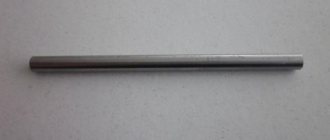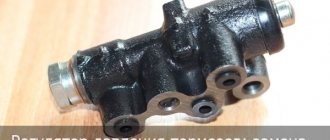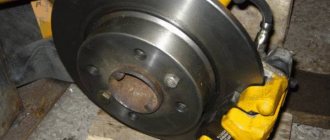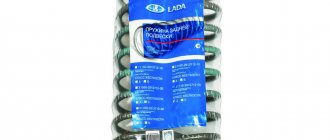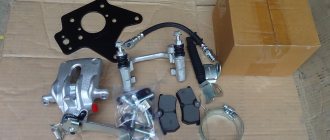On most passenger cars these are coil springs. Despite their simplicity and reliability, they fail over time.
After long-term (5–7 years) operation of the machine with a heavy load, they sag due to metal fatigue, while the travel and energy consumption of the suspension decrease. It starts to work all the way, which accelerates the destruction of body parts. Loss of spring elasticity is often discovered unexpectedly. For example, all summer two or three of us went to the dacha, but here we had to take guests and load the trunk thoroughly. The weight is no more than the permissible 400 kg for a Zhiguli, and the car is already “crawling on its belly,” clinging to the asphalt with its muffler.
But not all owners are in a hurry to buy new springs. Someone, having listened to other “experts”, installs rubber spacers under the springs (or between their coils). The main danger of such a solution is the possibility of the suspension being activated before the spring coils close and, as a result, almost hard impacts being transmitted to the body. In the standard design, the suspension makes its full stroke until it stops at a soft rubber or polyurethane bumper, which absorbs only the remaining energy. The spacer, replacing the air gaps between the coils of the spring, only limits the travel of the suspension, turning it from “soft spring” to “oak rubber”. If you transport a ton of cargo per trip on a VAZ-2104, then installing new springs to replace sagging ones is useless - and with them the loaded “four” will lie flat on the asphalt. And with spacers, the car will look “vigorous” for another year, until cracks in the side members disfigure its posture. The fact that the purchase of a new car will have to be taken into account in the estimate of upcoming production costs is not so bad. The main thing is that driving an overloaded car is simply dangerous. But if you use the car not so ruthlessly and count on its long service, there is only one way out - to install new springs designed for this model. For curious readers, we will tell you how suspension springs are made on a VAZ. The starting material is a rolled round rod made of spring steel grade 60S2GF. The first operation is processing of rods on turning lines to the required diameter, with removal of the top decarburized layer. The second is heating and spiral winding. Then – hardening and tempering. Then shot blasting: in a special chamber, the springs are fired with a stream of fine steel shot - this removes scale, strengthens the surface layer and increases fatigue strength. The next stage is cold draft, or spring captivity. They are compressed three times until the turns touch, after which the length decreases by approximately 18 mm from the original. Now the springs are ready to work for a long time without losing their elasticity. A protective coating is applied to the finished spring, otherwise, over time, cavities and cavities from corrosion will form on the surface of the rod, which will weaken the surface layer and accelerate the breakage of the spring. In addition to the traditional coating - black chlorinated rubber enamel, VAZ uses a more durable epoxy coating. For example, for rear suspension springs - only the latter. The final operation is static load control. 100% of produced springs pass it. Compressing the spring with a certain force, measure its length. For example, the spring of the “2101 front” model under a load of 435 kg has a nominal length of 232 mm, and at 603 kg - 182 mm. Springs whose length under load is greater or less (outside the tolerance) are rejected. Those that fall within the plus tolerance (that is, slightly longer than the nominal) belong to class A, and those within the minus tolerance (slightly shorter) – to class B.
Marking of springs for VAZ car suspensions
Color of distinctive markings
1111 front 1111 rear 2101 front 2101 rear 21012 front 2102 rear 2121 front 2121 rear 2108 front 2108 rear 2108 front European 2108 rear European 2110 rear 2111 rear 2112 front
yellow yellow yellow yellow white brown no mark (white) no mark (white) yellow yellow white brown no mark (white) orange white
green green green green blue blue black black green green blue blue black light blue no mark (black)
After this, the springs are marked by applying a strip of paint to the outer surface of the coils. Depending on the spring model (Table 1), yellow, green, white, blue, brown, dark blue, black and orange are used. And yet, despite such complex production technology, all springs sag sooner or later in operation. However, if you use more expensive material, you can create a spring that retains sufficient elasticity even with prolonged constraint. An example is the mainspring of a UZRGM grenade fuse. Being in a fully compressed state for fifty years, it slightly loses its elasticity and is always ready to work reliably, breaking the capsule with a striker. Of course, such high demands are not placed on car springs. What is the point of inflating their cost by making them “eternal” if in a few years more expensive components will require replacement? But the plant is obliged to ensure that the springs remain elastic at least during the design service life of the machine, and it succeeds. The same cannot be said about the “leftist” manufacturers whose springs appear on the market. But there are also conscientious manufacturers who have received VAZ approval to supply springs for spare parts. For example: construction machinery plant in Slavyansk; Crane manufacturing plant in Nikopol (both in Ukraine); Soyuz-TMO LLP, Izhevsk and Machine-Building Plant, Perm. The springs from these four factories are marked with the manufacturer's mark or a tag is attached. Now about the applicability of springs. Model 2101 (front and rear) - for all rear-wheel drive VAZs with a sedan body. 21012 - made of a larger diameter rod, it is stiffer than 2101. It is installed on the right side of the front suspension of Zhiguli with right-hand drive (export) to level the car due to asymmetrical weight distribution. On left-hand drive vehicles, the total weight of the steering mechanism, pedal assembly, hydraulic brake and clutch units, and instrument cluster located on the left side approximately corresponds to the weight of the battery, starter and generator on the right. With right-hand drive, all this is concentrated on one side, which required a reinforced spring on the right. Spring 21012 is also found on both sides of the suspension of Zhiguli special configurations with left-hand drive, which require increased energy intensity of the front suspension. Springs 2102 are installed in the rear suspensions of VAZ-2102 and 2104 station wagons. Their length is 21 mm longer than that of conventional “zero first” ones, and using them on sedans is justified only to increase the height of the body above the road, for example, if you have to often drive along a country road and hit bumps with the thresholds. But this does not mean that springs 2102 can be used to increase the load capacity of the machine - premature destruction of the body in this case is inevitable. Front springs 2108 are installed on all front-wheel drive VAZ models, except for the Oka and modifications with the new 16-valve engine. 2108 rear - for all front-wheel drive vehicles, except for the VAZ-2110 and Oka family. Owners of VAZ-21099 sedans are sometimes deceived in the markets by offering supposedly scarce “99” rear springs at exorbitant prices. Remember: these do not exist - the rear suspension of the VAZ-21099 has ordinary “eighth” springs. Springs for cars of the VAZ-2110 family are not yet in demand; however, we report data on their applicability (Table 2).
Properties of suspension springs
When torsion bars on vehicles were replaced with springs, handling improved and suspensions became more convenient to maintain. Springs maintain the vehicle's ground clearance, reducing vibrations and shocks while the vehicle is moving.
To make the ride comfortable, you need to choose the right parts. If the technical characteristics are unsuitable, then the positive properties of the suspension will be reduced to zero. Therefore, it is important to consider the following parameters:
- diameter - its increase affects rigidity;
- number of turns - as the number increases, the rigidity decreases;
- form.
Often, car owners strive to install stiffer parts in the suspension. This helps to increase the sensitivity of the steering wheel to the driver's control, but the grip on the road deteriorates.
Interesting
Very often, class A and B markings are also called hardness markings. Indeed, if you need to regularly travel with a full load, then it is better to use class A, as they can withstand a slightly larger load. However, this difference is small and amounts to approximately 25 kg.
Manufacturers do not always apply markings in accordance with the requirements of current standards. However, the color marking of the spring, assigning it to a certain class, must be applied. Moreover, it must be the same on both springs purchased, matching each other in color. If there is no such color marking, then it is better to refrain from purchasing them.
I like4I don't like1
Correspondence of spring markings to the model
When installing springs on a VAZ suspension, it is advisable to ensure their compliance.
- 2101 install on rear-wheel drive sedans.
- 21012 is tougher, made from a larger diameter rod. Installed on a VAZ with left-hand drive, with special equipment, when a front suspension with increased energy intensity is needed.
- 2102 are installed on station wagons VAZ-2102, 21014. Their length is increased by 21 mm compared to 2101, so they are installed on sedans only when you often have to drive on country roads so as not to hit bumps - when installing 2102, the ground clearance under body They cannot be used to increase the load capacity, since they inevitably lead to premature destruction of the body.
- 2108 is installed on all front-wheel drive models, except for modifications with a 16-valve engine and Oka. By the way, in the markets they often deceive owners of VAZ-21099 sedans by offering to purchase scarce “99 springs”. In fact, there are ordinary “eighths” there, and “99ths” do not exist at all.
- 2110 European ones are installed on the rear suspensions of VAZ 21102-21104, 2112, 2114, on the front and rear suspensions 21122 and 21124. The European version is created for cars intended for export. The ground clearance here is reduced by 20 mm, the compliance of the springs is reduced in order to increase their stability at high speed when turning. The cross-country ability of vehicles on off-road and dirt roads is significantly deteriorated.
- 2111 are installed on the rear suspensions of VAZ 2111 and 2113.
- 2112 are installed on the front suspensions of VAZ 21103, 2112, 21113.
- 2121 is used on all-wheel drive models, except Oka.
Interesting
Very often, class A and B markings are also called hardness markings. Indeed, if you need to regularly travel with a full load, then it is better to use class A, as they can withstand a slightly larger load. However, this difference is small and amounts to approximately 25 kg.
Manufacturers do not always apply markings in accordance with the requirements of current standards. However, the color marking of the spring, assigning it to a certain class, must be applied. Moreover, it must be the same on both springs purchased, matching each other in color. If there is no such color marking, then it is better to refrain from purchasing them.
Choice depending on manufacturer
Often, when parts break down, drivers try to buy original factory parts as replacements, not wanting to experiment. However, there is a decent choice from other manufacturers, whose products are sometimes no worse than the original ones.
Sirius
There is a large assortment for different brands of cars, and parts are also manufactured in any configuration according to customer drawings.
Phobos
The quality is satisfactory, but, according to some car enthusiasts, after 2 years they begin to sag, losing rigidity. In total, about 500 types of springs are manufactured under this brand for any brand of car; there are standard, reinforced and lowered springs. Clearance kits with increased ground clearance are also available.
Technospring
Good quality for little money. They lose rigidity over time, but do not sag. Quite good as a budget option.
Very durable, no sagging. They have a stiffness adjustment directly on the car, done with a special thumb under the hood.
Eibach
High-quality, very durable, practically do not “age” - do not sag, do not lose rigidity. There is no roll when turning. But they cost one and a half times more than Koni.
Products of the SS20 brand undergo mandatory testing at test benches, after which they are selected in pairs with similar characteristics. This check ensures, according to the manufacturer, 100 percent product quality. A large assortment allows you to choose the right characteristics depending on your driving style and operating conditions. There are 3 options available:
- hot coiling of standard height with linear compression characteristic;
- cold coiling of standard height with linear and progressive compression characteristics;
- cold coils are lowered, with a progressive compression characteristic.
Kilen
Alternative original springs from Kilen are of the highest quality. The service life, as the manufacturers claim, is twice as long as the original VAZ products.
Asomi
Excellent springs made from special alloys, coated with epoxy coating to increase service life.
Class “A” and “B” - significant differences
For many motorists, the decoding of hardness by color is identical to the classification by class. In short, the A-class is a stiffer option, regardless of the color of the spring coils, and the B-class is a softer option in the same color. The color of the coils helps not to confuse the springs of the main group. They should always be the same color. But small color stripes indicate a subgroup, or hardness class - A or B in a particular group.
When choosing new springs, you should pay attention to the markings. There are no significant differences between classes
The main thing is that to compress a type A spring to a certain height, you will need 25 kilograms more than an analogue of type B. If there is no marker on the spring, it is better not to buy such a part. The exception is parts that are not marked (they are indicated in the table).
In addition to safety, a car equipped with high-quality springs will become more comfortable. Such a vehicle makes the ride smoother, which has a positive effect on the driver’s well-being during long trips.
Installation Tips
- Is it possible to install parts of different classes?
Remember that the springs on the suspension must be of the same class. Let’s say you installed A-class parts on the front suspension, which means you also need to install “A” class on the rear suspension.
If a similar class is not available for the rear suspension, then in exceptional cases class “B” is assigned to the rear suspension.
If B-class springs are installed on the front suspension, then class “A” springs cannot be installed on the rear suspension.
Install suspensions of the same class on the left and right sides of the same axle.
Important
Class A, as well as class B, have an absolutely equal right to exist. Color marking was introduced in order to eliminate the difference in their height on opposite sides of the car. After all, installing springs of different heights on both sides of one car axle will lead to a deterioration in its handling and stability, and will also lead to rapid failure of chassis parts.
Experts recommend using springs of only one class. It is allowed to use class A in the front suspension, and class B in the rear. If class B springs are used in the front suspension, then installation of class A in the rear suspension is strictly prohibited. In any case, springs of both the same type and the same class must be installed on one axis.
Classification
There are several types of springs:
- Standard. As a rule, they are installed at the vehicle manufacturer’s plant and ensure its operation under the conditions of the specified load parameters.
- Reinforced. They are more rigid and improve the performance of the vehicle when driving on country roads or when transporting a trailer.
- Raising. Helps increase ground clearance and load capacity.
- Downgrades. Reduce ground clearance and lower the height of the center of gravity. Installed by fans of a dynamic driving style.
All of them, regardless of what type they belong to, have specific manufacturing features.
Main varieties
Four types of springs are widely used and are installed on all modern cars.
- Standard. They can be considered the basic option, which is installed at the factory during the manufacture of the car. Such elements are designed for vehicle operation under standard conditions, regulated by the vehicle’s technical passport.
- Reinforced. Designed to improve the performance characteristics of vehicles used in off-road conditions, during constant transportation of cargo or towing trailers.
- Inflating. After installation, they help increase the ground clearance and load capacity of the vehicle.
- Understating. Basically, such models are installed by fans of sports driving, since they lower the ground clearance and shift the center of gravity of the car downwards.
